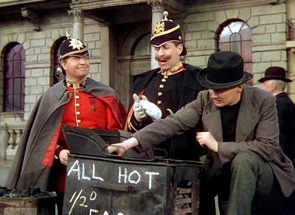Classic Movie Review: The Life and Death of Colonel Blimp
By Josh Spiegel
August 24, 2009
August 21st will be remembered in film geek circles as Avatar Day. On this day, thousands upon thousands of people (you may have been included, but I, alas, am not one of the lucky folk with a ticket) headed to an IMAX theater to see 15 minutes of James Cameron's first film in over a decade, Avatar. This film is obviously filled with what may be groundbreaking computer graphics, stuff that's guaranteed (hopefully) to inspire plenty of awe and drop a lot of jaws. And yet, as awesome as Avatar may end up being come this December, I wonder what it would be like to have lived back in the 1930s and 1940s, when technological breakthroughs in cinema were relegated to something we take for granted: the barrier between black & white and color.
Though the 1945 British film The Life and Death of Colonel Blimp wasn't the very first film to shoot in Technicolor, it is a notable progression in cinema history, a movie that not only was filmed in color, but made sure that every audience member was aware of it; all the colors in Colonel Blimp pop out, from the title character's shiny, almost waxy skin, to each grain of dirt on the World War I battlefield to even the mundane details. For this and many other reasons, Colonel Blimp is regarded as a classic, not only of British cinema, but of cinema in general.
Of course, if it hadn't been for Martin Scorsese, we might not know what treasures are truly in store during Colonel Blimp. The movie was shot during the height of World War II, written and directed by Michael Powell and Emeric Pressburger. Of all people, Prime Minister Winston Churchill found the film, which chronicles the life and death of a military man named Clive Wynne-Candy (Blimp is a bit of an apt nickname, but was also the name of a famous comic strip character in the United Kingdom during the 1930s and 1940s), to be blatanly unpatriotic and unsuitable for public viewing. We can forgive Churchill for being incredibly wrong in his choice here, but you have to wonder how much of his wartime attitude blinded his viewing of the movie.
Colonel Blimp was released in the States a few years later, but at a length of 90 minutes; seeing as the movie runs nearly 165 minutes, that difference is very noticeable. For decades, the film languished; however, thanks to Scorsese's fervent love of the Powell and Pressburger movies, Colonel Blimp was eventually restored in full and released as a Criterion Collection DVD. Powell and Pressburger thought the film was their best; I can't quite speak to that claim, as this is the first film of theirs that I've seen, but if their other work is half as good as Colonel Blimp, they had a great track record. Colonel Blimp is a patient movie, doling out character development deftly and smoothly, never hammering us over the head with exposition or unnecessary scenes. Yes, the movie is long, but as an examination of a life, it is wholly engrossing.
Continued:
1
2
3




